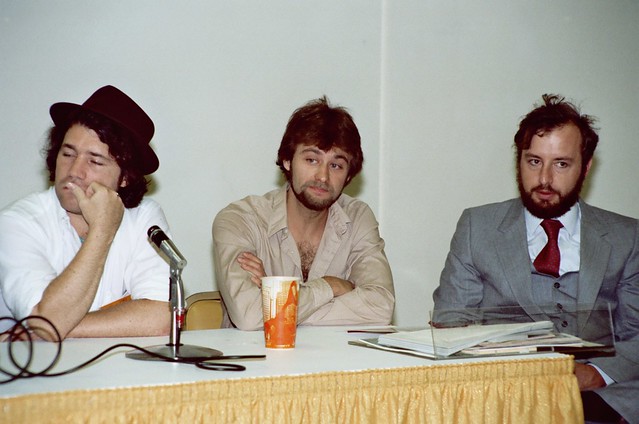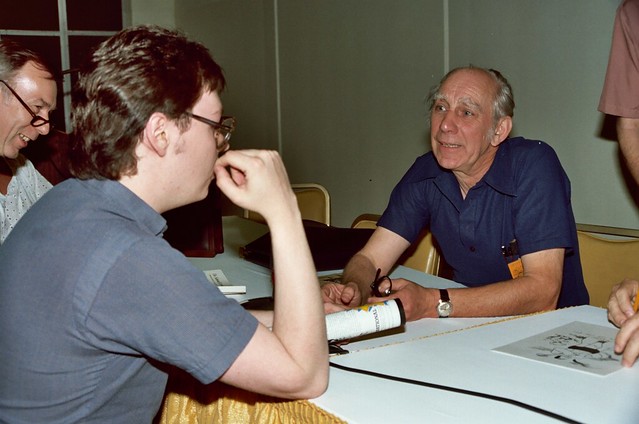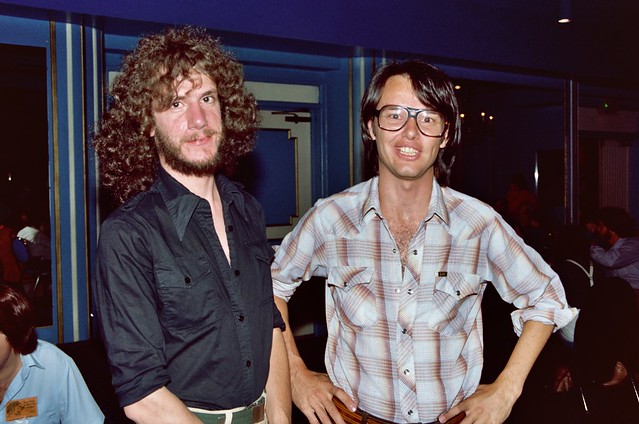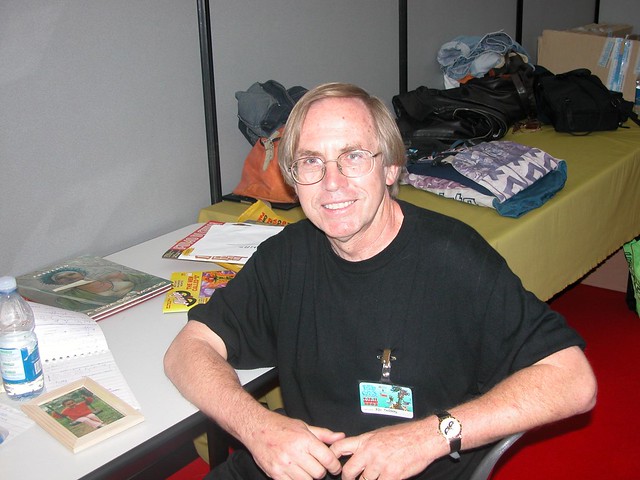Sunday, September 12, 2010
Top 10 Issues of The Comics Journal: #71 Part Three
"Suspended Animation: The Man of Spinach" (pages 97-100) by Jim Korkis [Seriously. Does it get any better than Mr. Korkis writing on the history of animation? As can be expected from Mr. Korkis, his column on the history of POPEYE cartoons begins with short histories of both the Fleischer Studios and the comic strip POPEYE. He then proceeds with a step-by-step evolution of the Fleischer POPEYE cartoons (from the pilot cartoon in the BETTY BOOP series) followed by the Famous Studios version, the ultra-streamlined television incarnation by Gene Deitch, a rare ABC Saturday morning feature-length one shot movie starring Popeye, and a 1978 Hanna-Barbera effort. Searching YouTube we can put together a visual version of Mr. Korkis' essay:
via
via
via
via
via
"Suspended Animation: Animation 1981 The New Age of Animation" (pages 100-101) by Jim Korkis [Not content with the minutiae-rich POPEYE animated history Mr. Korkis also follows the theme of the issue with a short overview of all-things-animation in 1981. Ralph Bakshi's AMERICAN POP; Disney's THE FOX AND THE HOUND; HEAVY METAL movie; and Warner Brothers THE LOONEY, LOONEY BUGS BUNNY MOVIE are the feature movies he discusses. While Leonard Maltin's OF MICE AND MAGIC; Jeff Lenburg's THE ENCYCLOPEDIA OF ANIMATED CARTOONS; Roger Maxwell's ART AND ANIMATION; Jerry Beck and Will Friedwald's WARNER BROTHERS CARTOONS; and, Frank Thomas and Ollie Johnston's DISNEY ANIMATION: THE ILLUSION OF LIFE are the books he lists from the previous year. Saturday Morning television cartoons from 1981 singled out are: SPIDERMAN AND HIS AMAZING FRIENDS; THE KID SUPER POWER HOUR (Captain Marvel); THE SMURFS; Jack Kirby's GOLDIE GOLD; HEATHCLIFF/MARMADUKE; and, the (then) new Disney television show WALT DISNEY ON CBS. Mr. Korkis also recalls the deaths the previous year of Michael Maltese, Steve Bosustow, Lotte Reininger, and Hans Conreid. He concludes with a look ahead to the animation front in 1982.]
"The Lake Isle: Sturgeon: Love as Knowledge" (pages 104-105) by Carter Scholz photo [This a short, yet detailed, review of Theodore Sturgeon's writing in general, and in particular his two short stories "Brownshoes" and "Slow Sculpture." Carter Scholz was a prolific science fiction writer and critic at this time, a bilbiography of his writings can be found here.]
"Panel Progressions: The EC Progressives, Part Two: Bernard Krigstein" (pages 107-112) by Greg Potter [This long-running column was inaugurated in The Journal 47 (July 1979) with a column analyzing Will Eisner (accompanying the second half of a Will Eisner interview that issue). Subsequent installments ran in in issues 53(Neal Adams); 59(Jack Kirby); 63(Alex Raymond and Hal Foster); 67(Harvey Kurtzman, reprinted in THE COMICS JOURNAL LIBRARY Volume 7 without a copyright notice); this issue; and, a last gasp version that ran only once (that I'm aware of) in The Journal 94 (BAT LASH, supposed to be "analyses of the great comic series of the 1960s and 1970s" page 110), these were "from a work in progress by Gregory Potter." (The Journal 47, page 56) Mr. Potter also had an off and on career as a comic book writer as detailed at GCD.
This issue's installment focuses on Bernie Krigstein and his work on "Master Race." After a brief (and not necessarily accurate) capsule history of Mr. Krigstein's career up until his EC days, Mr. Potter does a fine turn describing the "single panel theory" of sequential art, it's strengths and weaknesses, and how it differs from the prevailing attitude of Will Eisner's "cinematic" storytelling (for a more modern example of the former, I believe Jaime Hernandez's storytelling is similar). Following this introduction of Mr. Krigstein's techniques he examines in detail, panel by panel "Master Race" (IMPACT 1, 1955. writer: Al Feldstein) which is also conveniently reproduced in it's entirety along with this essay. Coming at the story from structural, storytelling, fine art, and historical viewpoints Mr. Potter brings added insight into what is, arguably, one of the more revolutionary achievements in mainstream comics.]
THE COMICS JOURNAL (c)2010 Fantagraphics Books Inc.
"Popeye" (c)2010 King Features Syndicate, just saying is all.
Thursday, September 9, 2010
Top 10 Issues of The Comics Journal: #71 Part Two
[This issue is an early version of the long-running "best-of-the-previous-year" editions that had it's first installment in, if I recall correctly, The Journal 44, and last in The Journal 296 (covering the best of 2008). In this particular instance editors, writers, reviewers, and columnists alike take a look at "Comics in 1981." Back in those days it seems there was Frank Miller's original run on DAREDEVIL representing the best of the Mainstream Super-Heroes, ELFQUEST/CEREBUS/Anthology magazines representing the "groundlevel" or independent companies, and RAW MAGAZINE representing the contemporary underground scene. Did I mention the writers got to choose the "best and worst" of 1981? This could get ugly, people!]
"The View From the Curb" (pages 31-33) by Jan Strnad [Jan Strnad chats about Marvel Comics, er, being too chatty, or having "too many words." He picks out Chris Claremont's 1981 AVENGERS ANNUAL and Roger Stern's Doctor Strange story "A Time For Love, A Time for Hate" as the most over-written of the Marvels he read. Bill Mantlo gets honorable mention for most annoying speech pattern for his "Bug" character in 'tik' MICRONAUTS. He has high praise for David Michelinie's IRON MAN, the Pini's ELFQUEST, and the aforementioned Chris Claremont's "Kitty's Fairy Tale" in X-MEN.]
"The Age of the Alternatives" (pages 33 35-36) by R. Fiore [Mr. Fiore singles out the above mentioned DAREDEVIL/CEREBUS/RAW trio for his take on Comics in 1981. Although, he does mention the long-forgotten PHANTOM ZONE mini-series by the late Steve Gerber and Gene Colan (both of whom are remembered more as the creative team behind HOWARD THE DUCK in the 70s) as a good turn on the Superman franchise. Mr. Fiore also takes the unique stand of comparing RAW MAGAZINE to it's two contemporary underground anthology competitors: WEIRDO and RIP OFF COMICS. The latter two don't fare too well in the comparison, Mr. Fiore perceptively adds, "The traditional underground (odd phrase) has a bad case of tired blood." Bravely, he also tackles the comic strips of the day, succinctly damning most of the field: "Three out of every four new strips about born losers. When Schulz started the trend it was a change of pace, but now with ZIGGY DRABBLE KUDZU ad infinitum ad nauseum, it's becoming a chorus of national demoralization. The fourth will be 'sophisticated' (read smug, enervated and hopelessly middlebrow). All four will be authored by someone who can't draw[...]" (excerpts (c)1982 Robert Fiore)
 "PUBLISHER: KIM THOMPSON [PHOTO] BY AMERICAN VIRUS" (source) image (c)2010 Jonas Seaman
"PUBLISHER: KIM THOMPSON [PHOTO] BY AMERICAN VIRUS" (source) image (c)2010 Jonas Seaman
"Waiting for the Fruit Salad" (pages 36-37 39-40) by Kim Thompson [Mr. Thompson wades into the three major anthology magazines of the day: HEAVY METAL is singled out as best of the group despite it's reliance on METAL HURLANT translations and mediocre to indecipherable American contributions; EPIC ILLUSTRATED is called out for not being consistent or "very good"; while ECLIPSE MAGAZINE recycled mainstream writers and artists to bad effect. Mr. Thompson has something to say on nearly everything else: Chris Claremont, John Byrne, Frank Miller, Steve Leialoha, Walt Simonson, Gil Kane, Michael Golden, KA-ZAR, Alan Brennert, Jim Aparo, Gene Colan, DENNIS THE MENACE (comic book), MARVEL TALES, "Mister Wilcox, Mister Conrad" by Munoz and Sampayo and Art Spiegelman's "Maus" both from RAW, FREAK BROTHERS, WEIRDO, Kitchen Sink Press, Howard Cruse, Reed Waller's "Omaha," PHOEBE AND THE PIGEON PEOPLE, NARD 'N' PAT, CEREBUS, THE COMPLET WEIRD FANTASY, THE COMPLETE SHOCK SUSPENSTORIES, ELFQUEST, REID FLEMING WORLD'S TOUGHEST MILKMAN, VALERIAN, LUCKY LUKE, GARFIELD, BLONDIE'S AMERICA. Mr. Thompson also suprises with this short note: "The Hernandez Brothers' LOVE AND ROCKETS, a witty and gorgeously drawn collection of stories and vignettes." This is the only other contemporary mention of the original self-published LOVE AND ROCKETS I've come across, besides the formal review by Gary Groth in The Journal 67.]
 GARY GROTH (middle) at 1982 San Diego Comic Con. PHOTO BY ALAN LIGHT (source)
GARY GROTH (middle) at 1982 San Diego Comic Con. PHOTO BY ALAN LIGHT (source)"Recycling the Old, Searching for the New" (pages 40-41 43-47 49-51) by Gary Groth [Mr. Groth examines Frank Miller's DAREDEVIL and Art Spiegelman and Francois Mouly's RAW MAGAZINE in depth in his take on Comics in 1981. He fires a salvo across the bow of the 1981 comics industry with this paragraph: "What the comics published in '81 make clear, I think, is the codification of two distinct points of departure for creating comics. Broadly speaking, every artist working in comics gravitatates toward one approach or the other. On one side is the traditional mass-market Marvel-DC-superhero format, and the other stems from the underground movement begun in the early '60s. The difference between these two approaches is fundamental and so vast that one ultimately represents paralysis, the other greater possibilities of expression." (excerpt (c)1982 Gary Groth)]
"Another Year for the Road" (pages 51-53) by Gene Phillips [Mr. Phillips comments on HEAVY METAL in 1981 in general, and Druillet's "Salammbo" serial in particular. EPIC ILLUSTRATED is again deflated as "the largest disappointment." General overviews of Marvel and DC's best and worst are followed by positive remembrances of CEREBUS 31 and "Gilbert Shelton, ELFQUEST, several concepts in RAW," as well as ECLIPSE MAGAZINE and early Pacific titles.]
"From Elfland to Smallville" (pages 53-56) by Dwight R. Decker [Mr. Decker comments on Frank Miller's DAREDEVIL, Roger Stern's SPIDER-MAN, Roy Thomas's work at DC, Cary Bates and Kurt Schaffenberger's SUPERBOY, ELFQUEST, THE FIRST KINGDOM, CEREBUS THE AARDVARK, and concludes with a short note on French Comics.]
 R.C. HARVEY (right) at the 1982 San Diego Comic Con. PHOTO BY ALAN LIGHT (source)
R.C. HARVEY (right) at the 1982 San Diego Comic Con. PHOTO BY ALAN LIGHT (source)"Newstand Comics 1981: The State of the Art" (pages 56-57 60-63) by R.C. Harvey; illustration: R.C. Harvey [Mr. Harvey dissects the storytelling strengths and weaknesses of Roy Thomas and Frank Miller. The latter is different than his essay on Frank Miller's DAREDEVIL in THE ART OF THE COMIC BOOK (University Press of Mississippi, 1996)]
"DE-ELFING COMICS" BY JOHN CLIFTON
(pages 64-67 69-74 76-77) [Mr. Clifton delivers a brutal, but ultimately perceptive essay on the overuse of fantasy elements (elves in particular) in then contemporary comics. ELFQUEST, WEIRDWORLD, and THE WIZARD KING are the targets on which he sets his critical sights.
Perceptive in that this essay belies the growing pains of comics and comics' critics as the comics market expanded in new directions. Mr. Clifton gives us the brilliant (and probably still true) theory that just because a comic is different in format or subject matter does not automatically anoint it as a superior effort than mainstream superhero comics. Mr. Clifton puts forth a unique theory which he lays out in this sentence: "Perhaps the three books examined would be more successful if they did not fall in one degree or another for the Elevator Fallacy, which stipulates that a heightened regard for a medium must be followed by its packaged or costly presentation in supposedly heightened formats." (page 74)
Fan favorite ELFQUEST is mercilessly deconstructed, whether it be storytelling weaknesses or illogic and false-ringing issues within the narrative. Early painted-comic experiment WEIRDWORLD (or "Warriors of the Shadow Realm" three-part magazine series and in EPIC ILLUSTRATED) is deplored for lazy, muddy coloring and inconsistent writing. Wallace Wood's THE WIZARD KING gets off fairly easily only being scolded for it's "worthless and insulting use of myth." (page 74)
Mr. Clifton's masterstroke may be the hubris he shows in the last two paragraphs of his essay, by comparing ELFQUEST and RAW: "But I don't wish to imply a relationship between such polar opposites of fandom fetish as ELFQUEST and the 'experimental' RAW MAGAZINE. Rather let me say it directly--RAW and ELFQUEST are identical! They are extremes that meet, in the intuition as in the fact, and together work to assure everyone concerned that yes, without question, without fail, comics history is moving onward, for our learning and intellect have signed the contract to keep it so. ELFQUEST is a thoroughly safe comic that gaurantees art in the comics today, this moment, through the right creatures and the right quota of sending. RAW is a thoroughly safe magazine that gaurantees us art, theoretically independent from anyone ever liking it, by giving us comics criticism and self-journalism in the form of panels, and by replacing mere imaginative activity with sure-stuff, cute-to-astute inventions of aesthetic-analytical speculation. Both provide a literalist, Time to Feel Important consumerist high for those obsessed with 'accomplishment' rather than inspiration, imprisoned wakefulness as over dreaming abandon, 'the state of comics' as against appreciating a comic and with conserving intelligently cultured laboratory specimens for the academical banter of fandom clerics, rather than making strips anyone will ever love, creatively experience, or play with again. RAW is medicine for bumptious sods and slithering psycho-wunks, so stapled with 'elevated values,' so adult, so much Velanna, we must give it dentures; gerontologists, not art, will have use for it. ELFQUEST can't even manage to be clearly bad; it sequentially teddy-bears us, teaches us supernatural inconsistency and societal garble, and celebrates 'the way' of happy determinism.
"It makes one almost want to start reading the X-MEN again--even mainstream hack was never like this. The real dispute on the direction of comics is not over whether it should be a child's medium or an adult medium, but over whether it is already an 'elevated art' or not. The adultists believe it is not, despise its centrally child-oriented locus, and cry into the night for its elevation, mostly through aesthetic speculation and adaptations; they suffer from a defective confidence in the medium as it is. Those who know that the comics medium already is elevated believe so precisely because the form has avoided eclipsing itself into academicist privatism, going thud in the dungeon on programmic, deadening research into 'itself'--remaining instead undirected, public, and child-centered for its very life; these are the progressives, for they are right. The difference is, as ever, in believing that the art is all around us and is external to us, versus believing that we have to work or borrow to 'achieve' it: perception and historical example versus invention and logical possibilities. RAW (actually well cooked and harmless) or comics? Elves (despite their fans) or comics? The dreamers for either have their work cut out for them." (page 77, excerpts (c)1982 John Clifton)
This unjustly forgotten piece also, in my opinon, has some weak points that get back to my point on the past growing pains of comics critics as well as the comics they wrote about. As when Mr. Clifton details the inconsistencies in both Wendy Pini and Art Spiegelman's storytelling and linework. This comparison seems to me (in hindsight, mind you) incongruous as both folks were coming at comics from two very different schools of thought (see Mr. Groth quoted above who deftly explains the difference).
Mr. Clifton also contributed two more essays to The Journal (as well as some letters in "Blood & Thunder"):
"The 7 Deadly Comics Cliches" illustrations: Joe Sinardi [in THE COMICS JOURNAL 53 (Winter 1980), yeah something else besides the infamous Ellison interview was in that issue!]
"Bite Now, Suckers" illustrations: [in THE COMICS JOURNAL 90 (May/June 1984), a supremely bizarre dialogue between the comic characters The Watcher, Cerebus the Aardvark, Vladek Spiegelman, and real-life character John Clifton. (source)]
 Dean Mullaney and MIKE FRIEDRICH (respectively) at the 1982 San Diego Comic Con. PHOTO BY ALAN LIGHT (source)
Dean Mullaney and MIKE FRIEDRICH (respectively) at the 1982 San Diego Comic Con. PHOTO BY ALAN LIGHT (source)INTERVIEWS:
"Reaching for the Stars With Mike Friedrich" (pages 79-81 83-87 89-92) interviewed by Kim Thompson ("[...]during the Summer of 1981[...]"). Transcribed and edited by Kim Thompson. Copy-edited by Mike Friedrich. photos: uncredited. [I'm not sure if it's possible to be someone as important as Mike Friedrich is to the history of comics to also be little-known outside of the industry today, but to me that's how it seems. Therefore this interview cames as a revelation to me as it details his journey from comics fandom, through writing for Marvel and DC, starting up his own comics company (Star*Reach) and its foreshadowing of independent comics/direct market of the early 80s, and finally his work as Manager of Direct Sales for Marvel Comics during the golden years of the Jim Shooter-era. There is also a wealth of firsthand details of the birth and infancy of the direct sales market and the rise of the specialty comics stores.]
[For a complete bibliography and history of STAR*REACH the comic, and a 2005 interview with Mike Friedrich conducted by Richard Arndt (who also interviews STAR*REACH contributors: Lee Marrs, Steve Leialoha, Trina Robbins, and Mike Vosburg) look at Mr. Arndt's site here.]
[For something more recent, here is a link to Mike Friedrich interviewing Bill Everett's daughter, Wendy Everett for COMIC BOOK ARTIST 2 (TwoMorrows Publishing).]
 Roy Thomas at the 2003 Torino Comics festival. PHOTO BY GIANFRANCO GORIA (source) image (c)2003 Gianfranco Goria
Roy Thomas at the 2003 Torino Comics festival. PHOTO BY GIANFRANCO GORIA (source) image (c)2003 Gianfranco Goria"Roy Thomas" (pages 94-96) moderated by Adam Malin at the Los Angeles Creation Convention (November 1981). Transcribed and edited by Gary Groth. illustrations: Kevin Nowlan [Wonder Woman, Arak/Captain Carrot!] [For a three-page convention transcript Roy Thomas talks about quite a few things, including his career history from fandom days through leaving Marvel for DC that year; writing CONAN for Marvel; writing ALL-STAR SQUADRON for DC; working with Gerry Conway (future LAW & ORDER franchise writer/producer) on the screenplay for Ralph Bakshi's FIRE AND ICE animated film; and, the general state of contemporary comics.]
THE COMICS JOURNAL (c)2010 Fantagraphics Books, Inc. All excerpted text is (c) the respective authors, only used under Fair Use.
[1982 San Diego Comic Con photos and many more comics and celebrity related photos can be found on Alan Light's Flickr home page.]
[More photos of Fantagraphics Books staff and cartoonists can be found on the American Virus Flickr home page.]
[More pictures of comic book personalities in foreign countries can be found on Gianfranco Goria's Flickr home page.]